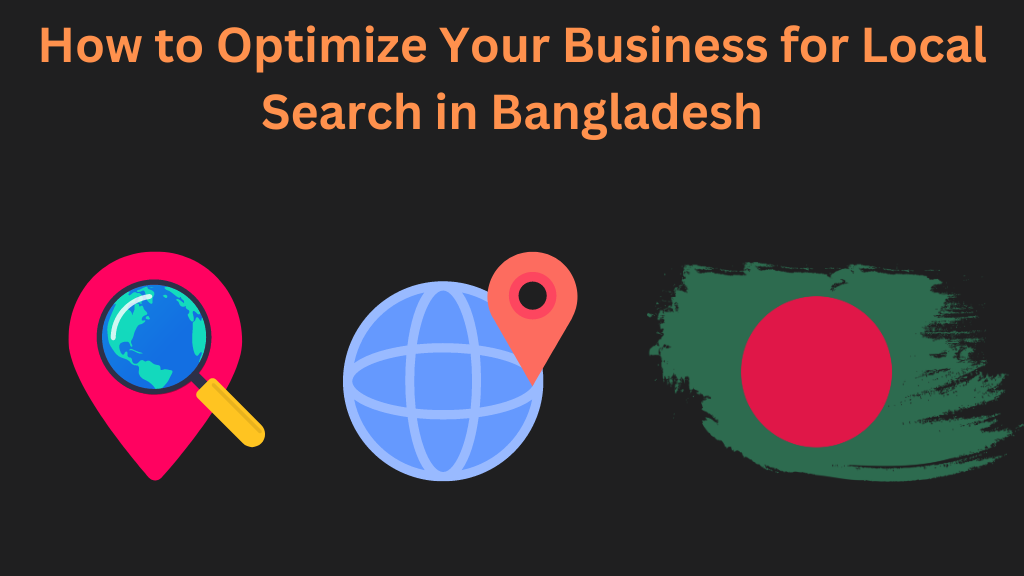In the bustling markets of Bangladesh, where local businesses clash for supremacy, the digital realm offers a unique battleground to capture customer attention. Optimizing your business for local search isn’t just about being seen—it’s about being found by the right people at the right time. This comprehensive guide will walk you through the essentials of local SEO tailored specifically for businesses operating in Bangladesh, ensuring that your enterprise doesn’t just participate in the digital landscape but thrives in it.

Table of Contents
ToggleUnderstanding Local SEO
Before diving into the technicalities, it’s crucial to understand what Local SEO (Search Engine Optimization) entails. It’s a strategy that helps your business become more visible in local search results on Google and other search engines. Essentially, when potential customers in your area search for products or services you offer, you want your business to pop up on their screen, right? That’s what local SEO is all about.
Why Local SEO Matters in Bangladesh
Bangladesh’s digital penetration is growing exponentially. With more people turning to Google to find local businesses, appearing in these searches can significantly increase your visibility:
- Reach the Right Audience: Local SEO helps you reach potential customers in your specific geographic area.
- Boost in Traffic and Sales: Higher visibility means more traffic, both online and offline, which can lead to increased sales.
- Edge Over Competitors: Many local businesses may not be optimizing for local search effectively, giving you a chance to get ahead.
Step-by-Step Guide to Kickstart Your Local SEO
Step 1: Google My Business Setup and Optimization
Your journey starts with Google My Business (GMB), a free tool that lets you manage your online presence across Google, including Search and Maps. To optimize your GMB listing:
- Claim Your Listing: Verify your business on Google My Business. This step is critical as it helps in establishing authenticity.
- Complete Your Profile: Fill out every part of your GMB profile, from operating hours to contact details and categories.
- Regular Updates: Keep your profile updated with fresh content and announcements. Regular posts can keep your audience engaged.
Step 2: Local Keywords Research
Identifying and using the right local keywords is like setting up signposts that lead straight to your business. Use tools like Google Keyword Planner to discover what potential customers are searching for locally:
- Include Geographic Tags: For instance, instead of just “handicrafts,” use “handicrafts in Dhaka.”
- Service-Based Keywords: Incorporate service-related keywords that include local names, like “Rajshahi mango delivery.”
Step 3: On-Page SEO Enhancements
On-page SEO involves tweaking the content and structure of your website to make it more search-engine friendly:
- Title Tags and Meta Descriptions: These should be compelling, include local keywords, and accurately describe your page content.
- Header Tags: Organize content clearly using headers (H1, H2, etc.) to improve user experience and SEO.
- Local Content: Create blog posts or articles about local events or issues related to your business sector to engage a local audience.
Step 4: NAP Consistency
NAP stands for Name, Address, and Phone Number. Consistency in how your NAP appears across the internet can significantly affect your local search rankings:
- Consistent Information: Ensure your business’s NAP is the same on your website, social media pages, and online directories.
- Local Phone Numbers: Use a local phone number instead of a central call center helpline to reinforce local presence.
Step 5: Cultivating Local Backlinks
Backlinks — links from other websites to yours — are a critical component of SEO. For local SEO, gaining backlinks from well-regarded local websites (like local newspapers or business associations) can boost your credibility and rankings:
- Engage with Local Influencers: Collaborate with local bloggers and influencers who can review your business.
- Participate in Community Events: Sponsor or participate in community events and get featured on their websites.
Step 6: Leveraging Social Media
Social media doesn’t directly impact SEO rankings, but it influences local search engine visibility through increased online presence and website traffic:
- Local Engagement: Use your social media platforms to engage with local customers and post about local events.
- Location Tags: Always tag your location in posts and stories to increase visibility in local search results.
Step 7: Mobile Optimization
With the increasing use of smartphones, having a mobile-friendly website is essential:
- Responsive Design: Ensure your website looks good on all devices, including desktops, tablets, and phones.
- Speed Optimization: Use tools like Google PageSpeed Insights to ensure your site loads quickly on mobile devices.
Step 8: Encourage Reviews and Manage Online Reputation
Reviews are a critical component of local SEO and can significantly influence potential customers. Positive reviews not only improve your business’s credibility but also enhance your search engine rankings.
- Encourage Reviews: Prompt satisfied customers to leave positive reviews on your Google My Business listing and other relevant platforms.
- Respond to Reviews: Engage with reviewers by responding to their comments. Address negative reviews professionally and offer to resolve issues.
Step 9: Local Structured Data Markup
Structured data markup, often referred to as schema markup, can be added to your website’s code to provide search engines with more information about your business, such as products you sell, services offered, and reviews collected. This data helps search engines display your business more prominently in local searches.
- Implement Local Business Schema: Use the LocalBusiness schema to provide details like your business address, opening hours, and payment methods.
- Test Your Markup: Use tools like Google’s Structured Data Testing Tool to ensure your markup is implemented correctly.
Step 10: Optimize for Voice Search
With the rise of digital assistants like Siri, Alexa, and Google Assistant, voice search is becoming increasingly important. People often use more conversational phrases in voice searches, which means tweaking your SEO strategy to accommodate this:
- Use Long-Tail Keywords: Incorporate more natural, long-form content that answers common questions related to your business.
- FAQ Pages: Develop FAQ pages that directly answer potential questions customers might ask using voice search.
Step 11: Leverage Local Business Directories
Aside from your Google My Business listing, your presence in local online directories can boost your local SEO efforts. These directories help increase your digital footprint and improve your local visibility.
- List on Popular Directories: Ensure your business is listed on directories like Bdtradeinfo, Bangladesh Yellow Pages, and other local directories.
- Maintain Consistency: As with your GMB listing, ensure your business information is consistent across all directories.
Step 12: Track Your SEO Performance
Tracking your performance is crucial to understanding the effectiveness of your local SEO efforts and identifying areas for improvement.
- Use Analytics Tools: Google Analytics and Google Search Console are invaluable tools for monitoring your website’s traffic and performance.
- Regular Audits: Conduct SEO audits regularly to check for issues like broken links, outdated content, and SEO optimization opportunities.
Continuous Improvement and Adaptation
SEO is not a set-it-and-forget-it activity. It requires ongoing effort and adaptation to changing technologies and market dynamics.
- Stay Updated: SEO practices and guidelines evolve, so it’s important to stay informed about the latest trends and updates from Google.
- Experiment and Learn: Try different strategies, see what works, and continually refine your approach based on analytics data.
Conclusion
Optimizing your business for local search in Bangladesh is a dynamic and ongoing process. It involves a mixture of foundational practices and advanced techniques, all aimed at enhancing your visibility and attracting more local customers. By implementing these strategies, monitoring your results, and adapting to new SEO trends, your business can achieve notable growth and a strong local presence in the digital world.
Remember, the landscape of digital marketing and SEO is perpetually evolving. Keeping abreast of new technologies, updating your strategies, and maintaining a proactive approach to customer engagement and feedback are key to sustaining success in local search rankings. Start implementing these strategies today, and watch your local business rise to new heights in the bustling markets of Bangladesh.





